仁爱版七年级上册Unit2 Looking different Topic1 SectionA课件(共20张PPT)
文档属性
| 名称 | 仁爱版七年级上册Unit2 Looking different Topic1 SectionA课件(共20张PPT) |  | |
| 格式 | zip | ||
| 文件大小 | 5.1MB | ||
| 资源类型 | 教案 | ||
| 版本资源 | 仁爱科普版 | ||
| 科目 | 英语 | ||
| 更新时间 | 2022-09-08 09:52:00 | ||
图片预览

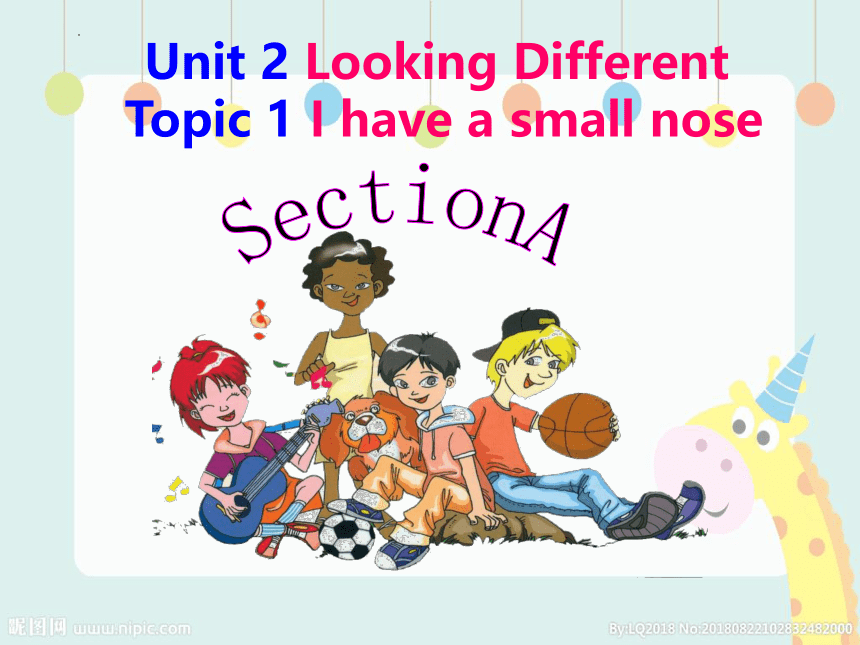

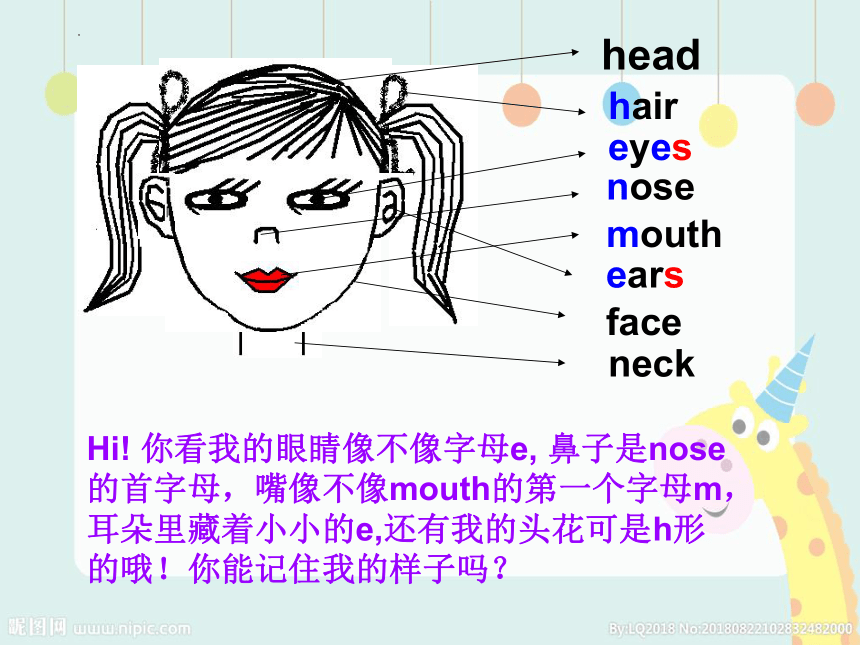
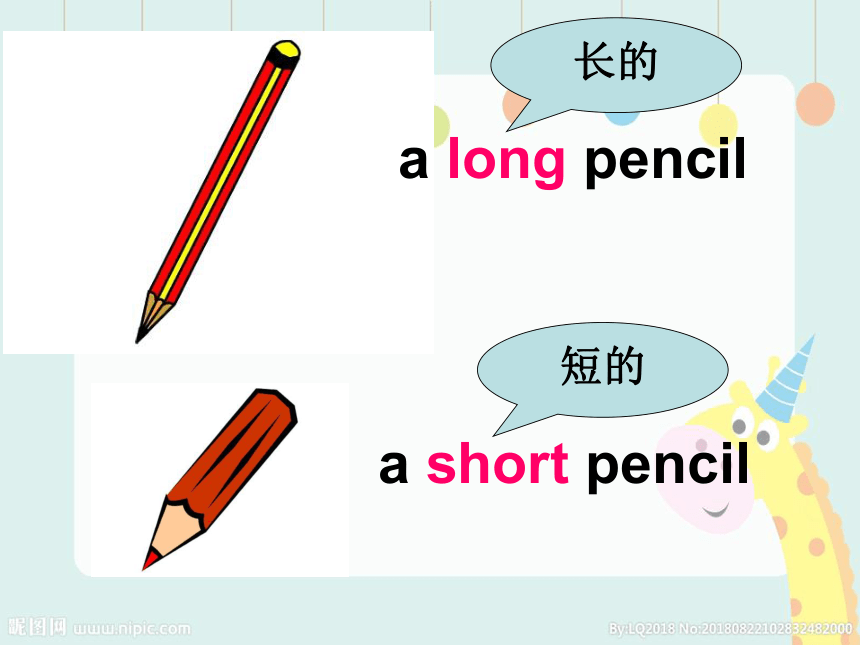
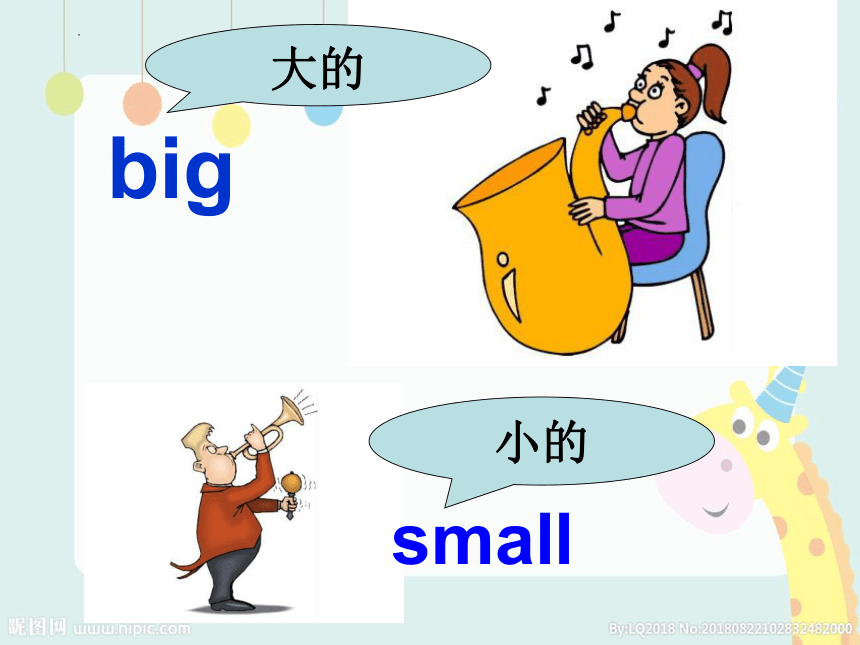


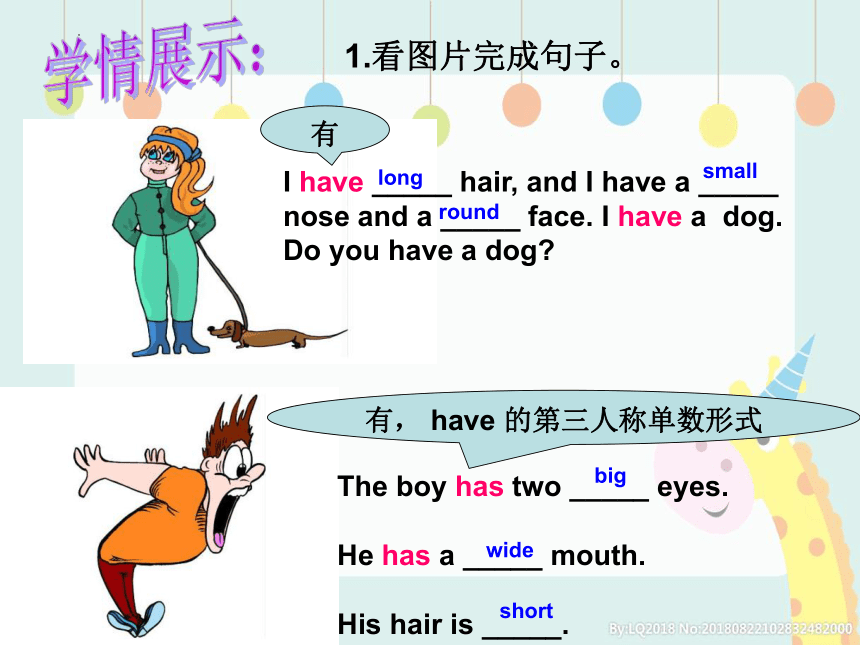
文档简介
(共20张PPT)
Unit 2 Looking Different
Topic 1 I have a small nose
SectionA
学习目标:
1.能正确朗读描述人身体部位及人物外貌特征的词汇。
2.学会正确使用have/has。
3.能用简单的英语描述及询问人物外貌和体格特征。
4.了解字母o,u,r,y及字母组合ng的读音规则。
eyes
nose
mouth
ears
face
hair
neck
head
Hi! 你看我的眼睛像不像字母e, 鼻子是nose的首字母,嘴像不像mouth的第一个字母m,耳朵里藏着小小的e,还有我的头花可是h形的哦!你能记住我的样子吗?
a long pencil
a short pencil
长的
短的
big
small
大的
小的
The boy has a round face.
He has a round ball.
The is round.
圆形的
His mouth is wide.
宽的
注意: 在英语当中说嘴巴大时,一般用wide,而不用 big mouth, 因为 big mouth 通常指“多嘴多舌”。
学情展示:
1.看图片完成句子。
The boy has two _____ eyes.
He has a _____ mouth.
His hair is _____.
有, have 的第三人称单数形式
I have _____ hair, and I have a _____ nose and a _____ face. I have a dog. Do you have a dog
有
long
small
big
wide
short
round
They have round_____.
She has_________.
He has____________.
It has_______.
We have small
_________.
I have a
big________.
Look, listen and fill.
nose
eyes
faces
long hair
a wide mouth
big ears
学情展示:
Yes, I do.
Do you have big eyes
认真听录音,并完成1b。(2分钟)
1b.Listen to 1a and mark T(True) or F(False).
1.Kangkang has big eyes.( )
2.Michael has a small nose.( )
3.Kangkang has a big nose.( )
4.A is Michael.( )
guess [ɡes] 猜
know [n ] 知道
right [ra t] 正确的
T
F
F
F
自研共探
have/has 表示归属,意思为“有”。主语为第三人称单数(he/she/it/Kangkang/ Lily’s dad)时,用has,
其他人称(I/you/we/they/ Kangkang and Lily)做主语时用have.
例子: I have a big nose.
He has a big nose.
3b Work alone
Complete the following sentences.
have\ has
You ____ a round face.
I _____ a wide mouth.
He\Kangkang _____ a big head.
She\Jane _____ long hair.
We _____ big ears.
They _____ small eyes.
It _____ a long neck.
have
have
has
has
have
have
has
学情展示:
Summary
耳朵
头
脸
嘴
头发
眼睛
脖子
鼻子
长
大的
圆的
宽的
ear
head
face
mouth
hair
eye
neck
nose
long
big
round
wide
he
she
it
has
I
we
you
they
have
Listen and match.
ear
head
face
mouth
hair
eye
neck
nose
2. 单选题。
( )1.The dog(狗) is small. It ____ small _____.
A. have, eyes B. has, ear
C. has , ears D. have, eye
( )2. Li Lei and Kangkang _____ big eyes.
A. has B. have C.are D. is
( )3.--- Do you have big eyes
--- Yes, I _____.
A. do B. are C.is D.can
3.仿照1a编写新的对话。
C
B
A
Good-bye!
Unit 2 Looking Different
Topic 1 I have a small nose
SectionA
学习目标:
1.能正确朗读描述人身体部位及人物外貌特征的词汇。
2.学会正确使用have/has。
3.能用简单的英语描述及询问人物外貌和体格特征。
4.了解字母o,u,r,y及字母组合ng的读音规则。
eyes
nose
mouth
ears
face
hair
neck
head
Hi! 你看我的眼睛像不像字母e, 鼻子是nose的首字母,嘴像不像mouth的第一个字母m,耳朵里藏着小小的e,还有我的头花可是h形的哦!你能记住我的样子吗?
a long pencil
a short pencil
长的
短的
big
small
大的
小的
The boy has a round face.
He has a round ball.
The is round.
圆形的
His mouth is wide.
宽的
注意: 在英语当中说嘴巴大时,一般用wide,而不用 big mouth, 因为 big mouth 通常指“多嘴多舌”。
学情展示:
1.看图片完成句子。
The boy has two _____ eyes.
He has a _____ mouth.
His hair is _____.
有, have 的第三人称单数形式
I have _____ hair, and I have a _____ nose and a _____ face. I have a dog. Do you have a dog
有
long
small
big
wide
short
round
They have round_____.
She has_________.
He has____________.
It has_______.
We have small
_________.
I have a
big________.
Look, listen and fill.
nose
eyes
faces
long hair
a wide mouth
big ears
学情展示:
Yes, I do.
Do you have big eyes
认真听录音,并完成1b。(2分钟)
1b.Listen to 1a and mark T(True) or F(False).
1.Kangkang has big eyes.( )
2.Michael has a small nose.( )
3.Kangkang has a big nose.( )
4.A is Michael.( )
guess [ɡes] 猜
know [n ] 知道
right [ra t] 正确的
T
F
F
F
自研共探
have/has 表示归属,意思为“有”。主语为第三人称单数(he/she/it/Kangkang/ Lily’s dad)时,用has,
其他人称(I/you/we/they/ Kangkang and Lily)做主语时用have.
例子: I have a big nose.
He has a big nose.
3b Work alone
Complete the following sentences.
have\ has
You ____ a round face.
I _____ a wide mouth.
He\Kangkang _____ a big head.
She\Jane _____ long hair.
We _____ big ears.
They _____ small eyes.
It _____ a long neck.
have
have
has
has
have
have
has
学情展示:
Summary
耳朵
头
脸
嘴
头发
眼睛
脖子
鼻子
长
大的
圆的
宽的
ear
head
face
mouth
hair
eye
neck
nose
long
big
round
wide
he
she
it
has
I
we
you
they
have
Listen and match.
ear
head
face
mouth
hair
eye
neck
nose
2. 单选题。
( )1.The dog(狗) is small. It ____ small _____.
A. have, eyes B. has, ear
C. has , ears D. have, eye
( )2. Li Lei and Kangkang _____ big eyes.
A. has B. have C.are D. is
( )3.--- Do you have big eyes
--- Yes, I _____.
A. do B. are C.is D.can
3.仿照1a编写新的对话。
C
B
A
Good-bye!
同课章节目录
- Unit 1 Making new friends
- Topic 1 Welcome to China!
- Topic 2 Where are you from?
- Topic 3 How old are you?
- Unit 2 Looking different
- Topic 1 I have a small nose
- Topic 2 What does she look like?
- Topic 3 Whose jacket is this?
- Unit 3 Getting togethe
- Topic 1 Does he speak Chinese?
- Topic 2 What do your parents do?
- Topic 3 What would you like to drink?
- Unit 4 Having fun
- Topic 1 What can I do for you?
- Topic 2 Would you like to cook with us?
- Topic 3 What time is it now?
